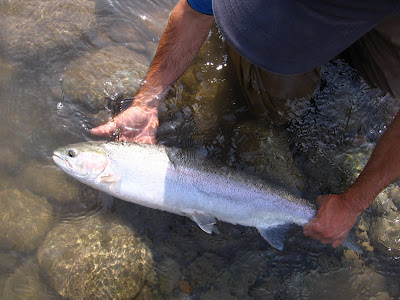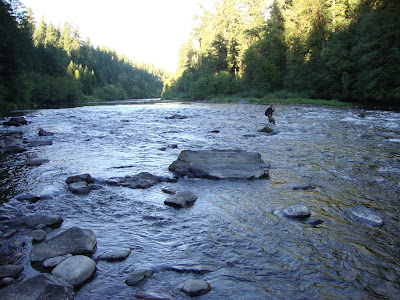
Washington State hatcheries or outplants which release more than 10,000 fish
A post on
Chasing the Scraps got me thinking...why not one river without hatchery fish? There certainly aren't many in Washington.
The state has stopped planting smolts in SOME systems without collection facilities. But the Puget Sound is still loaded with hatchery fish and in many parts of the state fish continue to be released with absolutely no prospect for collecting them. WDFW releases all these fish without ever monitoring the impact of hatcheries on wild populations or the proportion on the spawning grounds.
Managers may not be paying attention
but it doesn't change the fact that the number of hatchery fish that spawn in the wild each year is massive. In Willapa Bay the state manages
chinook and coho stocks as integrated, doesn't mark hatchery fish and allows up to a
90% harvest, essentially guaranteeing the extirpation of wild salmon through overfishing and hatchery introgression.
In Puget Sound the state basically closed fishing to protect wild steelhead. Last year WDFW adopted a rule change that closes every river in the Puget Sound except the Skagit on February 15th meaning that they don't see wild populations being able to support incidental C&R mortality in the near future. If populations are fragile enough that they cannot sustain the limited mortality of a sport fishery, how can the impacts of hatcheries possibly be justified? Ocean survival is widely acknowledged to be limiting Puget Sound steelhead populations and yet we continue to release millions of smolts a year, swamping the limited carrying capacity of the sound with unfit hatchery fish. Managers recognize that marine survival is the limiting factor for salmon and steelhead in the sound but have largely shrugged their shoulders as if they have no control over what goes on in the marine environment. Even if the factors associated with survival in the marine environment are poorly understood, the one management tool we have at our disposal is reducing the number of steelhead and salmon released from state hatcheries. This is made necessary not only by the ecological impacts of the system, but also economic realities and the tremendous cost of failing state hatcheries. When hatchery fish are costing taxpayers 800 bucks a pop the system is broken. If the state hatchery system was a private business it would've been bankrupt ages ago, instead we've continued to subsidize fisheries to the tune of nearly 60 million
dollars a year. Despite all this spending we continue to loose more and more angling opportunity every year and wild fish are further than ever from recovery. If we hope to recover listed steelhead and chinook in puget sound we need to start accounting for the full impacts of the hatchery system. Why not dramatically reduce the number of hatchery programs in Puget Sound and see if wild fish make a recovery? At this point we're basically out of other options.
Just implementing the State Wide Steelhead Management plan (SWSMp) and some of the recommendations made by the HSRG would represent a major step forward but since its adoption in early 2008 almost none of the SWSMp has been carried out. Worse yet, the year of its adoption, the Quinault tribe knowingly dumped IHN infected smolts into Lake Quinault. Then last year IHN appeared on the Quilleyute system forcing hatchery managers to destroy the entire brood year of adults. The Statewide Steelhead management plan had supposedly put an end to out of basin transfers of hatchery stock, yet in the first test of that policy WDFW opted to transfer tens of thousands of fish from the Hoko hatchery and outplanting of hatchery smolts continues in dozens of rivers around the state.
Now on the Elwha, the greatest salmon restoration project of our lifetimes, they're planning not only to mine wild eggs for broodstock, but also to continue releasing 60,000 chambers creek smolts annually, despite the fact that the river will be closed for five years to any angling. That just doesn't make any sense. At some point it just becomes hatcheries for their own sake. And can anyone actually cite an example of a system where a broodstock program has successfully increased the abundance of wild fish over the long run? A similar project on Hood Canal boosted spawner abudance during the life of the program, but last year only 42 fish returned. Despite uncertain benefits of such a captive breeding program, it has been expanded to a number of other Hood Canal tributaries. A broodstock program on the upper Kalama has been taking about 50 wild fish out of the population annually since 1999 with no appreciable increase in the abundance of wild spawners and the wild broodstock program at Snider Creek has arguably been the least successful hatchery in the state over the last 25 years. Wild fish have shown a tremendous capacity to colonize habitats and the remaining wild fish on the Elwha provide a direct link to the river's evolutionary past. They are the key to recovering the Elwha's once vast wealth of wild salmon. But we have to give them a chance.
Undoubtedly there is a role that hatcheries and selective fisheries can play in our society, but the scale and cost of the current system is not only wasteful but also environmentally destructive. As Kurt Beardslee of the
Wild Fish Conservancy says, the Elwha could be a paradigm changer, a grand experiment in the ability of Wild Salmon to recover without the influence of hatcheries. I think most people would be surprised just how quickly populations of wild salmon will grow in the Elwha once the dams are removed. As the western most river in the Puget Sound the Elwha may be less hindered by probelms with early marine survival as many other rivers in the ESU. Some hatchery advocates have cited concerns about high sediment loads in the Elwha as a justification for the wild broodstock program, but think about how much of the watershed wont be affected by dam removal. Tributaries, stable spring-fed offchannel habitats and the mainstem above the dam sites will all provide large refuges for wild spawners.
Wild fish in the Elwha have endured a century of clinging to their existence in the lower 5 miles of river. Miraculously though, they're hanging on. A few hundred wild chinook return annually to the Elwha system, and a small population of steelhead will benefit greatly from healthy numbers of rainbows upstream. Trapped rainbows in the upper river continue to produce smolts every year and bull trout remain in healthy numbers above the dams. The Elwha is arguably the most pristine river in the Lower 48, now with the dams gone the fish will finally be able to use it fully. So why not one river without hatcheries?
Chasing the Scraps:
http://scrapchaser.blogspot.com/Elwha Fishing Mortatorium on the Osprey:
http://ospreysteelheadnews.blogspot.com/2010/12/wdfw-accepting-comments-on-elwha.html










































